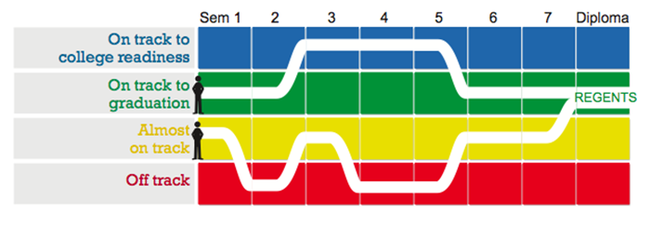Generating Regents Diplomas in New York City: A Lesson in the “Fixes That Fail” Archetype
Beginning in 2009, New York State’s Board of Regents began phasing out the less rigorous Local Diploma. As of 2012 all general education NYC students must meet the requirements for the Regent’s Diploma to graduate from high school. Even though increasing numbers of students in NYC are now graduating with a Regents Diploma thanks in large part to this NYC Department of Education policy, not all Regents Diplomas are created equal.
Here we see two students enter their freshman year of high school with different academic proficiency levels.
One student is on track to graduate from high school, the other student is almost on track. The student who starts out on track has two major transitions, one between the second and third semester to a higher performance category, the other between the 5th and 6th semester to a lower performance category. The other student has five different transitions indicative of a much more volatile and less consistent trajectory. Both earn a Regents Diploma, but their academic histories are prologue to future post secondary outcomes.
At New Visions we looked at the Class of 2008 students in our network of 75 New York City schools. It came as no surprise that those graduating with a more advanced diploma had more successful college outcomes. Approximately 76% of students who graduated with an Advanced Regents Diploma were enrolled in a four-year college two years after graduating from high school, as compared to 49% of students who graduated with a Regents diploma, and 23% who graduated with a Local diploma.
When we looked more closely at the students who earned a Regents Diploma, it was clear how different student pathways (see the image above) shaped post secondary outcomes. Approximately 76 percent of students in the Class of 2008 who graduated with a Regents Diploma and who were on track to college readiness in their 7th semester of high school, were still in college two years after graduating from high school. Conversely, only 48 percent of students who were off track in their 7th semester and who earned a Regents Diploma persist in college. In other words, we catch students just before they drop out or just before they fail to graduate high school but we have not sufficiently addressed their skill and content vulnerabilities such that they will succeed in college. Catching students “just in time” and then applying a quick solution typifies a common systems thinking archetype: fixes that fail.
In a fixes that fail scenario, a problem symptom presents (e.g., high school seniors on the cusp of not graduating within four years). The obvious course of action is to implement a solution that alleviates a symptom (e.g., credit recovery). The solution fails to address a root cause of the problem (e.g., authentic content and skill mastery), and eventually the problem symptom returns or worsens (which comes to life in the “Kicking The Can” archetype).
One of the objectives of the school is to increase the total number of on track, high performing students. To do so, schools apply resources (interventions) to students. The application of resources can have different consequences depending upon when they are applied. Chris Soderquist and I have mapped out a fixes that fails systems thinking map that helps illustrate this idea of higher versus lower leverage interventions. Please note, this map is underspecified in that it does not address the quality of interventions. Our aim via this map is to illustrate the system dynamic related to the fixes that fail archetype.
To see how a fixes that fails solution turns into a much bigger problem at a later point, read more about another system’s archetype: Kicking The Can Down The Road!
